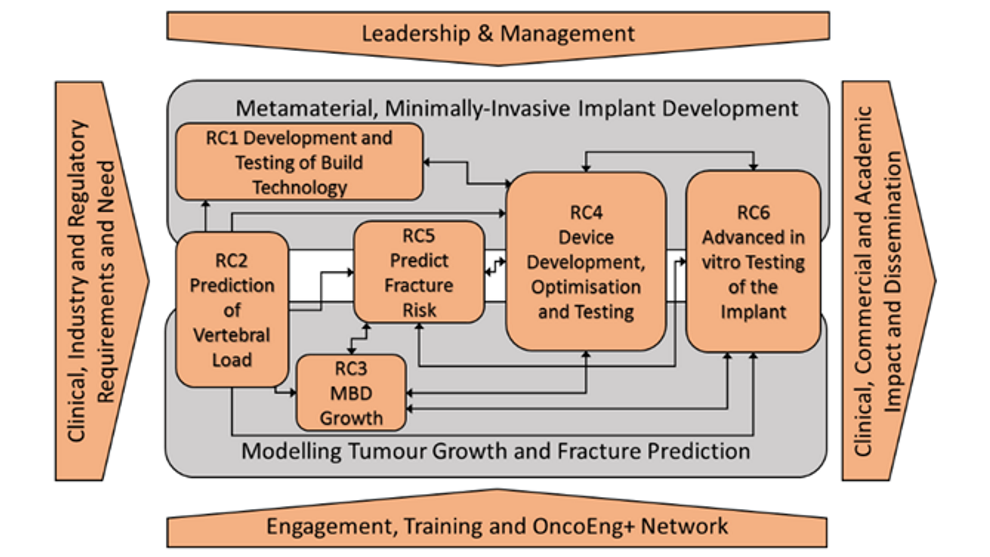The programme grant is built on 6 Research Challenges (RCs) corresponding to the objectives. These RCs will be overcome in an integrated and holistic fashion with information and sample flows between them:

The key interdependences of the individual RCs across the two main objectives.
The key research challenge is the development of a printer capable of manufacturing a MII to the required specification in terms of materials, build size and parts resolution to allow the required metamaterial functionality in a lesion specific manner. Initial work by the applicants on formulating this response to the need indicates that the build volume-to-resolution specifications are outside the limits of current technologies.
Key outputs: (1) Novel manufacturing technology, (2) ability to manufacture the MII to the required specification to realise a metamaterial MII. These outputs are key for the device development in RC4 and construct testing in RC6.
The principal challenges are centred on the development of advanced rigid-bodymodelling techniques to deliver unique spinal data in patients and discernment of the effects of pathology and pain on the biomechanics.
Key outputs: Load-motion spectra for ADL at the VB level including adverse scenarios which accelerate failure. Key for RC1/4 initial specification of the printer and design of the MII, RC3/RC5 the mechanical environment for tumour growth and fracture and RC6 for the testing regimes.
The key challenge is the development of a novel, integrated solid/fluid model of MBD growth. The model will incorporate complex interactions between tumour components which allow the prediction of MBD growth and bone loss in VBs with underpinning imaging.
Key outputs: Step change in our understanding of the biomechanical mechanism of MBD growth in VB. Key for RC5 where fracture prediction and tumour growth are integrated to allow prediction of VB failure in the future.
One of the key challenges will be how the small scale lattice geometry (~ microns) is represented at the large scale (~ cm) efficiently. The Imperial research team has experience of developing concurrent multiscale optimisation, but capturing the non-linearities is a key issue in this application in ways that are computationally efficient.
Key outputs: Optimisedmetamaterial MII for lesion specific implantation. Digital design solutions for the implant sent to RC5 for in silico testing and MII to RC6 for in vitro testing.
Here the research challenge is the development of an advanced image-based in silico model to couple mechanical stress in the growing metastasis, surrounding tissue and vertebrae, and forecast fracture within the VB.
Key outputs: Comprehensive framework for the forecasting of fracture risk in VB and subsequent mitigation utilising the MII. Information on bone strain environment needed for the design of the MII in RC4 and identification of refined adverse scenarios for testing in RC6.
The key challenge here is the generation of realistic testing protocols and deployment of the implant using in vitro and ex vivo processes which go beyond the short lifetimes for ex vivo tissue testing (<24 hours) and the simplified loads used (universally quasi-static compression).
Key outputs: A testing regime that integrates the computational framework from RC5 and the experimental framework from RC6.